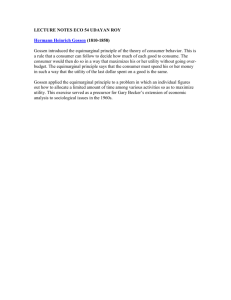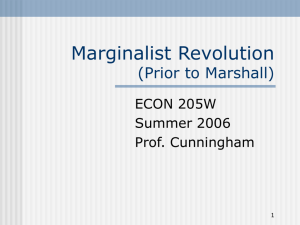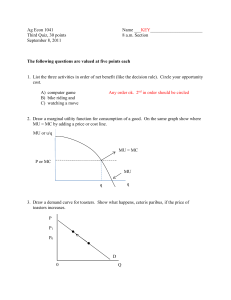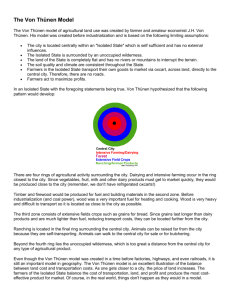Anticipations of Marginalism - College of Business and Economics
advertisement
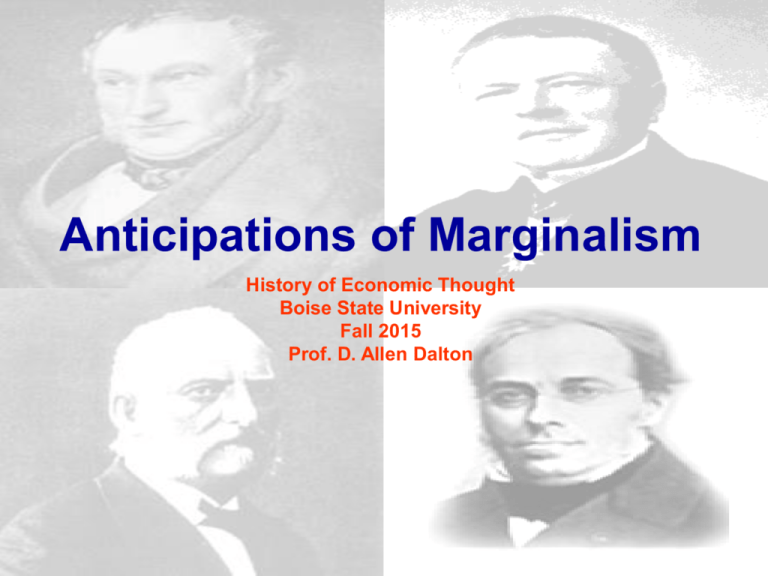
Anticipations of Marginalism History of Economic Thought Boise State University Fall 2015 Prof. D. Allen Dalton Background • Throughout history there exists a strong subjective utility theory of value – Olivi and San Bernardino – Late Spanish Scholastics – Galiani and Turgot – French School – British Oxford-Dublin School • This view is buried under the Smith-RicardoJ.S. Mill onslaught that propounds a labor theory/cost-of-production theory of value Background • The height of this older subjective theory found in the French “Engineers,” most prominently, Jules Dupuit • Also during the Classical period, a few lonely voices appear (von Thünen, Cournot, and Gossen) that are generally viewed as anticipators of the Marginalist “Revolution” and the transformation of economics from a concentration on economic growth to an emphasis upon resource allocation – these latter contributions might be viewed as “Marginalism without the name” Johann Heinrich von Thünen • Johann von Thünen (1783-1850) – born into landowning family, took over deceased father’s two estates at age 16 – studies agronomy at Celle under Albrecht Thaer, father of rational agriculture; critical of Thaer’s economics, studies economics at University of Göttingen – Returns to agriculture, purchasing large estate from brother-in-law – Becomes internationally recognized authority on agriculture von Thünen’s Contributions • The Isolated State with Respect to Agriculture and National Economy (1826, 1850) – works out central idea first conceived in 1803: that net prices obtained by farmer decline with increasing distance from market; that relative prices will influence choice of crops and techniques at differing distances from the market – Constructed his theory from scratch – Derived economic propositions from explicit optimization, though book does not use differential calculus – Pioneer in mathematical economics von Thünen’s Contributions • Theory of Rent, Location and Resource Allocation – product sold at fixed price (p) – transportation costs (t) rise with increasing distance (s) – output per acre (q) increases with labor input per acre (a) at a diminishing rate: q’(a) negatively sloped with respect to a – at each p, farmer chooses production method such that MP of labor, evaluated at p, equals the wage rate (w) von Thünen’s Contributions p t pq’(a)=w q’(a) s Labor intensity a • As distance (s) from market increases, producer price declines, marginal product of labor rises, labor intensity falls and rent falls. • Generalized to multiple crops to predict spatial pattern of crop production von Thünen’s Contributions Rent Vegetables Forest Rye s • Farmers seek to maximize rent; at margin, respective products yield same rent • Extends model to account for how changes in conditions affect location of production, intensity of factor use and rents (transportation costs, technology, etc.) von Thünen’s Contributions • Marginal Productivity Theory of Distribution – second part of The Isolated State (1850) – “effectiveness” of capital and labor both measured by the increment in the output due to the increase in the quantity of the factor – both labor and capital are increased up to the margin “where the value of the incremental output of the last worker (or “last particle of capital”) is absorbed by the wage received (or “payment to capital”) • The “Natural Wage” – attempt to determine the wage (when savings are excess over subsistence) that will maximize the return on savings (why?)….. w* = pa von Thünen’s Influence • Universally acclaimed, his book had immediate success • Most of success due to “natural wage” • Other aspects lay largely dormant • Presented analysis idiosyncratically; weighed down with numerous tedious numerical examples, digressions and repetitions • If presented succinctly and translated into plain language, he might have inaugurated the Marginal “Revolution” • Marshall reads him circa 1869, later credits von Thünen with teaching him economics Antoine-Augustin Cournot • Antoine A. Cournot (1801-1877) – 1823, math degree from Sorbonne – private secretary to French marshal (1823-1833) • wrote doctoral dissertation in mechanics and secondary thesis in astronomy, obtained law degree, published numerous articles – 1834, Poisson obtains for him a professorship at University of Lyon – 1835, elected rector at University of Grenoble; distinguished career as university administrator till retirement Cournot’s Contributions • Researches into the Mathematical Principles of the Theory of Wealth (1838) – pioneering, systematic analysis of profit maximization by firm – presented by use of differential calculus – unreviewed, Cournot retreats from economics, and not until 1863 did he write on economics again, presenting his theory stripped of mathematics • “Hamlet without the prince of Denmark..for his one original contribution was precisely the use of calculus to solve problems of constrained optimization” Cournot’s Contributions • Researches into the Mathematical Principles of the Theory of Wealth (1838) – begins with market demand, where q = F(p) • first demand function and demand curve – Firm revenue, R = pF(p) • maximized at dR/dp = F(p) + pF’(p) = 0 – Begins with monopoly, works towards competition – Production costs depend on quantity • C = Φ(q) = Φ[F(p)] – Profit maximization; Π = R - C = pF(p) - Φ[F(p)] • dΠ/dp = F(p) + pF’(p) - Φ’(q)F’(p) = 0 Cournot’s Contributions • Researches into the Mathematical Principles of the Theory of Wealth (1838) – analysis of effects of changes in marginal cost – analysis of effects of taxes (notes excise tax is equivalent to shift in demand or cost curve) – Duopoly Theory • homogeneous product, ignores costs • q = q1 + q2 = F(p) • Cournot assumption: each firm expects the other’s output to be independent of resulting market price and optimizes output accordingly Cournot’s Contributions • Duopoly Theory – reaction curves: q2 r1 B C r2 A q1 • q1 = r1(q2) • q2 = r2(q1) – at A, firm 2 finds firm 1 has produced less than expected, expands output to B; firm 1 then finds firm 2 has produced more than expected…. – if r2 is steeper than r1 then outcome is unstable • first time that stability requirement used Cournot’s Contributions • Researches into the Mathematical Principles of the Theory of Wealth (1838) – Pure Competition • as number of firms expands, price become parameter for each firm so that each firm supplies according to parametric price – qi = qi(p) • Market price determined by aggregate supply equaling aggregate demand – Σ qi(p) = F(p) Cournot’s Influence • Developed and applied tools of constrained optimization - in one stroke, the theory of the firm had been created • Introduction of calculus into economist’s toolkit • Immediate influence negligible; economists did not understand calculus - contributions neglected until later • Influenced following generation of Jevons and Walras • Marshall reported that he learned his method from Cournot (remember he said he learned his economics from Thünen) Hermann Heinrich Gossen “He was a man of one idea; but that was an immortal one.” - F.Y. Edgeworth, Palgrave’s Dictionary of Political Economy • Hermann Heinrich Gossen (1810-1858) – father tax collector under Napoleon – changed schools several times before dropping out, gaining diploma through independent study – university studies concentrated on law and government – entered civil service in 1834, forced to resign in 1847 due to poor performance – entered insurance business briefly, then set about developing his ideas Gossen’s Contributions • Entwickelung der Gesetze des menschlichen Verkehrs (1854) (translated in 1963 as The Laws of Human Relations and the Rules of Human Action Derived Therefrom) – published at Gossens’ expense – few copies sold, Gossen withdrew it from circulation – first noted and understood by Robert Adamson, who had found an obscure reference to it, obtained one of few circulating copies, and reported content to Jevons – Jevons devotes 6 pages of 2nd edition of his The Theory of Political Economy to a tribute to Gossen’s originality Gossen’s Contributions • Analysis starts with optimal allocation of time • Gossen’s First Law – “The magnitude of a given pleasure decreases continuously if we continue to satisfy this pleasure without interruption until satiety is ultimately reached” – marginal utility curves drawn for marginal unit of resources (time) applied • Gossen’s Second Law – “The magnitude of each single pleasure at the moment when its enjoyment is broken off shall be the same for all pleasures.” – principle claim to fame Gossen’s Contributions • Application of Gossen’s Second Law u v(e) u* E E – Allocation of resources (ei)to activities yielding pleasure u(e) - Production: activities reinterpreted as products and resources as effort, where effort is disutility - v(e) Gossen’s Contributions • Application of Gossen’s Second Law – Exchange • perceives indeterminateness of bilateral exchange • he postulates that marginal utilities must be equalized between individual’s for each product (presumes cardinality and interpersonal comparability) but foreshadows equality of MRS – Market Exchange • parametric prices; E reinterpreted as income and product curves reinterpreted as marginal utility per currency unit spent and v(e) interpreted as disutility of earning income at current prices • conclusion: “the last atom of money creates the same pleasure in each pleasurable use” Gossen’s Philosophy • Second part of The Laws of Human Relations is a passionate defense of free markets – free trade, private property, antimonopoly, liberal education, metallic currency, abolition of paper money – did see sources of inefficiency in land ownership; proposed government buy land and then lease to highest bidder – talked of competitive markets as if they were the revealed perfection of a benevolent God Francesco Ferrara • Francesco Ferrara (1810-1900) – Self-taught economist – Leading Sicilian liberal during period of reform and revolution – Professor of political economy, University of Turin (Italy) – Two-volume History of thought (Esame storico-critico di economisti e dottrine economiche, 1889-92) gives special place to Say, Dunoyer, and Bastiat Ferrara’s Contributions • Analyzes human choice in the context of utility and “cost of reproduction” – Both ideas are subjective; “cost of reproduction” close to the opportunity cost concept – Viewed utility as declining and “cost of reproduction” rising as an activity is extended – Exchange value and price arise from the foundations of choices undertaken by comparing utility and “reproduction cost” – influences Vilfredo Pareto, Maffeo Pantaleoni (first Italian marginalist), Luigi Einaudi Supply and Demand Geometry • Supply and Demand analytics are the most frequently used tool of microeconomics. • The economists who anticipated the “marginal revolution” were involved in the development of these tools. • Cournot, Karl Rau, Jules Dupuit, Hans von Mangoldt, and Fleeming Jenkin contributed to the development of demand/supply analytics from 18381870. Supply and Demand Geometry • By 1870, supply and demand had been utilized to: (1) depict equilibrium, (2) show how price/quantity adjustments ensure equilibrium, (3) examine price elasticity, (4) show how shifts in demand/supply alter equilibrium, (5) analyze the incidence of taxation, (6) examine the welfare effects of taxation, (7) analyze price discrimination, (8) distinguish between market period and long-run equilibrium, (9) analyze the pricing of joint products. Supply and Demand Geometry Antoine Augustin Cournot in his Researches (1838): (1) First to draw a market demand curve, showing the demand function as a function of sales at different prices. (2) In identifying the revenuemaximizing price as that which occurs when dD/dp = D/p, and that revenue rises or falls as dD/dp is less than or greater than D/p, he discovered the concept of price-elasticity of demand. Supply and Demand Geometry Cournot: (1) Introduced the first supply curve as a positive function of price, arguing that marginal cost rose as a function of output; (2) identify the competitive equilibrium as occuring where the curves intersected; (3) show the effect of a per-unit tax on the competitive equilibrium, noting that price rose by less than the tax so long as demand was negatively –sloped; (4) and, noted that the portion of the tax shifted to buyers varies inversely with the price-elasticity of demand. Karl Heinrich Rau • Karl Heinrich Rau (1792-1870) – Born in Erlangen, Bavaria. – Studies at University of Erlangen (1808-1812), becomes Privatdozent and then professor in 1818. – Becomes Chair of Political Economy at University of Heidelberg in 1822 and remains there till his death. – Author of leading textbook from 1826-1854, Grundsätze der Volkswirthschaftslehre (Principles of Political Economy). – Maintained all prices should be treated within demand-supply framework. Supply and Demand Geometry Karl Heinrich Rau was the first economist to use the supply-demand diagram to investigate the stability of market equilibrium and show the forces that restore equilibrium when disturbed. In the 4th edition (1841) of his Grundsätze, he argued that if price is other than at equilibrium, an excess demand or excess supply arises that leads to sellers to alter the price they are charging, until equilibrium is restored Jules Dupuit • Jules Dupuit (1804-1866) – French civil engineer – Educated at Ecole Polytechnique (Paris) – 1824, entered service of Administration of Bridges and Highways, eventually rising to chief engineer in charge of Paris municipal services – Most of books on engineering subjects, second half of life became interested in economic problems Dupuit’s Contributions • Most important economic contributions – “On the Measurement of the Utility of Public Works” (1844) – “On Tolls and Transport Charges” (1849) • How should public works investments be valued? • Three fallacies – utility of public work isn’t measured by its cost – utility isn’t measured by saving in transportation costs allowed (increase in Q, increase TC) – utility isn’t measured by increase in quantity transported valued at constant price (because value declines with increased quantity) Dupuit’s Contributions • The “Two Laws of Demand” – First Law : demand curves slope downward with respect to price constructs demand curve based on “maximum sacrifice willing to be made to acquire given quantity” - negatively sloped because extra quantities of a good add less to total satisfaction. – Second Law : the demand curve is convex because of the “pyramid of income distribution” Dupuit’s Contributions • Distinguishes between “absolute utility” (total) and “relative utility” (consumer surplus) • The price op measures the utility of only the last unit purchased. • The trapezoid oPnr measures “absolute utility”, the rectangle opnr measures the total expenditure on the good, and the triangle pPn measures “relative utility.” Dupuit’s Contributions • The triangle nNr is the utility lost due to price constraint – under competitive conditions when resources are scarce, the units rN are worth less than the price necessary to have them produced. • If this depicts a costless monopoly charging oP, however, then nNr is the value of goods consumers artificially lose (the first diagram to depict deadweight loss of monopoly). Dupuit’s Contributions • Welfare effects of a per-unit tax. – the imposition of a tax results in a loss of consumer surplus that exceeds the yield of the tax. Consumers lose “relative utility” (consumer surplus) that is not offset by any gain. Dupuit’s Contributions • Pricing policy for utilities – Notes that discriminatory pricing reduces dead-weight losses and notes classpricing for railroads achieves such a goal Hans von Mangoldt • Hans von Mangoldt (1824-1868) – Text, Grundriss der Volkswirthschaftslehre (1863) (Outline of Political Economy). – Explicitly references Rau, and his stability analysis, like Rau’s, highlights the price-equilibrating role of excess demand and excess supply. Supply and Demand Geometry - Relates the height of the demand curve to marginal utility and the downwardsloping nature to diminishing marginal utility - Identifies changes that can shift the demand curve: population, tastes, knowledge, income and wealth - Identifies exceptions to law of demand – conspicuous consumption and price expectations Supply and Demand Geometry Identified different shaped supply curves with the behavior of costs of production (a) constant cost; (b) constant cost up to a fixed capacity; (c) constant costs that yield to increasing costs and then fixed capacity; and, (d) decreasing costs due to economies of scale followed by increasing costs due to diseconomies of scale. Supply and Demand Geometry First extended comparative statics exercises, and posits a three-step adjustment process for unanticipated shifts in curves: (1) a shift in the curve, which (2) produces a gap between supply price and demand price at existing output that alters profits, which (3) induces a change in the quantity supplied to restore equilibrium. Supply and Demand Geometry Extended analysis of joint product cases: “joint demand,” “joint supply,” “composite demand” and “composite supply.” • Joint demand - purchased in fixed proportions; joint supply - produced in fixed proportions; composite demand –two competing uses for a fixed input; composite supply – two substitute goods supply a single need. Exceeds J.S. Mill’s statement concerning the necessary conditions that must hold for the profitable production of jointly supplied goods to an analysis of the demand and supply adjustments necessary to bring the conditions into fruition. Fleeming Jenkin • Fleeming Jenkin (1833-1885) – Born Dungeness, Kent, England – Educated in Scotland, Frankfurt, Paris and Genoa, learned engineering at the University of Genoa – Professor of Engineering, University of Edinburgh from 1868 – Inventor of telpherage (aerial tramway), electrician, cable engineer, linguist, critic, actor, dramatist, artist – Memorialized by his student Robert Louis Stevenson in Memoir of Fleeming Jenkin Supply and Demand Geometry In three papers published in 1868, 1870, and 1872 Jenkin presented demand-supply analysis in application to labor, trade unions, and the incidence of taxes. Differentiated between market period and long-run, introduced idea of reservation prices of suppliers during market period based on future price expectations. Supply and Demand Geometry Analyzed comparative statics due to demand curve shifts (whims, tates,expectations, income) and supply curve shirts (size of stock on hand and expectations) in market period and due to changes in cost of production in long-run. Supply and Demand Geometry Analyzed tax incidence on the basis of the slopes of demand and supply curves, derived the concepts of consumer surplus (priority to Dupuit) and producer surplus and noted that the welfare loss to consumers and producers always exceed the tax they pay.
